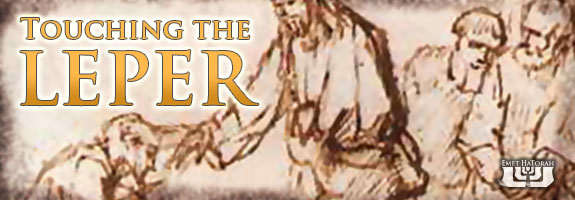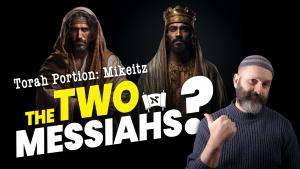Touching the Leper - Part 1

And a leper came to him, imploring him, and kneeling said to him, “If you will, you can make me clean.” Moved with pity, he stretched out his hand and touched him and said to him, “I will; be clean.” And immediately the leprosy left him, and he was made clean. And Jesus sternly charged him and sent him away at once, and said to him, “See that you say nothing to anyone, but go, show yourself to the priest and offer for your cleansing what Moses commanded, for a proof to them.” (Mark 1:40-44)
This is a story with which most people are familiar. During one of his return visits to the Galilee, Yeshua encounters a leper who begs for healing. Yeshua, being filled with compassion, touches the leper and he is healed instantly. However, there is more going on in this incident than what lies on the surface. Let's take a quick look at some of the components that underly the passage and help break down some of the things the author assumes of the reader.
Biblical Leprosy
First, let's take a look at biblical leprosy. The typical mental image painted by Sunday School lessons and Sunday morning sermons is of a debilitating disease which leaves a person marred and disfigured, with lesioned flesh and missing fingers and toes. We often envision the disturbing images from Southeast Asia and Central Africa as examples of what biblical leprosy would have been like. However, these are misrepresentations that we are forcing onto the Scriptures due to the use of the English word, "leprosy." Biblical leprosy is known as tzara'at (צרעת) and has no relation to modern leprosy, otherwise known as Hansen's Disease. Unlike Hansen's Disease, which is a bacterial infection affecting the skin and the nervous system, biblical leprosy — tzara'at — involves none of these symptoms. In fact, you'll be surprised at how very different these two diseases are from one another. The parameters of tzara'at can be found in Leviticus chapters 13 and 14. In the introduction to Leviticus 13, most Bibles will have a footnote saying something to the effect of, "Leprosy was a term for several skin diseases." If we closely examine the text, however, we will see that tzara'at was very specific in its identification. It had to meet certain criteria before it could be labeled tzara'at by the cohen (priest). Also, we find that not only is it associated with a skin condition, but it can also be a type of mildew-like substance that can appear on the walls of a house (Lev. 14:33-53), or in fabric or in leather-goods (Lev. 13:47-59). Other distinguishing factors of biblical tzara'at are its severity and transmission. According to the biblical texts, tzara'at does not transmit physical ailment akin to Hansen's Disease. It does, however, transmit ritual impurity (making one "unclean"). "A person or object in contact with a leper becomes both unclean and contaminating." 1 What does this amount to? It amounts to an ostracizing of the metzora (a "leper" in biblical terms). In other words, when one has been diagnosed as being a metzora, one must remove himself from the community so as not to "infect" others.
The leprous person who has the disease shall wear torn clothes and let the hair of his head hang loose, and he shall cover his upper lip and cry out, ‘Unclean, unclean.’ He shall remain unclean as long as he has the disease. He is unclean. He shall live alone. His dwelling shall be outside the camp. (Lev. 13:45-46)
Although this seems like a harsh treatment for someone who has a non-life-threatening, semi-communicable impurity (and not a disease, per se), one must remember that this command was given while the children of Israel were wandering in the wilderness and encamped together in close quarters. Any contact (intentional or not) with other people or objects would immediately transfer ritual impurity to the person or object, thus rendering them tamei (טמא) as well. This contact with ritual impurity would make these individuals unable to participate in communal worship and the sacrificial system. In order for this to be contained, the priesthood was commissioned with identifying and quarantining outbreaks of tzara'at. A metzora had to undergo routine inspections to monitor the condition of their infection. We have to keep in mind, however, that ritual impurity (being "unclean") is in no way equivalent to sin. Being "unclean" was part of the routine of life during the days when the Tabernacle or the Temple were standing. Women became ritually impure during their monthly cycle or during childbirth. Both men and women became unclean with any kind of bodily emission. Tzara'at, however, was one of the most severe cases of ritual impurity, even surpassing corpse contamination, since one was only able to be purified on the condition the symptoms had vanished. Once the symptoms were completely gone an elaborate series of sin offerings, sprinklings, immersions similar to the purification rituals of corpse contamination were required in order to be declared officially clean ("ritually pure"). The only way sin would be connected to impurity is if an unclean person entered the Holy Temple. They would be guilty of defiling the earthly abode of the Almighty and be held liable. There is, however, an odd condition in regard to tzara'at which makes its spiritual / ritual nature explicit. Once a metzora was completely consumed with tzara'at, and covered from head to foot and has turned completely white, he was pronounced tahor (טהור) clean / ritually pure and was free from his quarantine (Lev. 13:12-13). Once new skin began replacing the infection, however, he was quarantined once again and the entire inspection cycle was begun anew. There was no known cure for tzara'at. The priesthood did not affect the affliction, but only diagnosed it.
Causes of Leprosy
Based off of several Scriptural inferences, the Talmud states that there are seven sins for which one may be afflicted with leprosy:
R. Samuel b. Nahmani said in the name of R. Johanan: Because of seven things the plague of leprosy is incurred: [These are:] slander, the shedding of blood, vain oath, incest, arrogance, robbery and envy. (b.Erachin 16a)
Both the Talmud and the Midrash Rabbah see the word metzora as a compound word comprised of the words "motzi [shem] ra" (b.Erachin 15b; Leviticus Rabbah 16:2). In effect, this means one who "brings forth [an] evil [name]." In other words, a leper is one who spreads gossip and slander. The sages viewed evil speech as so damaging that they interpreted slander to be one of the most grave sins:
Further said Resh Lakish: One who slanders makes his sin reach unto heaven, as it is said: They have set their mouth against the heavens, and their tongue walketh through the earth. R. Hisda said in the name of Mar ‘Ukba: One who slanders deserves to be stoned with stones… Further said R. Hisda in the name of Mar ‘Ukba: About one who slanders, the Holy One, blessed be He, says to the prince of Gehinnom: I shall be against him from above, you be against him from below, and we shall condemn him, as it is said: Sharp arrows of the mighty, with coals of broom. ‘Arrow’ means nothing else but the evil tongue, as it is said: Their tongue is a sharpened arrow, it speaketh deceit; and ‘mighty’ means only the Holy One, blessed be He, as it is said: The Lord will go forth as a mighty man; and ‘cools of broom’ is Gehinnom. R. Hama b. Hanina said: What is the remedy for slanderers? If he be a scholar, let him engage in the Torah, as it is said: The healing for a tongue is the tree of life, and ‘tongue’ here means the evil tongue, as it is said: ‘Their tongue is a sharpened arrow’, and ‘tree [of life]’ means only the Torah, as it is said: She is a tree of life, to them that lay hold upon her. — But if he be an ignorant person, let him become humble, as it is said: "But perverseness therein is a wound to the spirit." (b.Erachin 15b)
If this is the case, it is interesting to note that this is one of the few instances in which Yeshua did not also tell the one he was healing that his sins were forgiven. Why? Because sins committed against God can be pardoned by either God or His earthly agent. However, the only way sins committed against another living human being can be pardoned is from the one whom we have wronged (Matt 5:23-24; John 20:23). In my next post, I will look closely at Yeshua's encounter with the leper and the various implications involved in this incident which we typically miss or gloss over.
Footnotes
1. Torah Club 4: Chronicles of the Messiah, p.323 (footnote 7)








